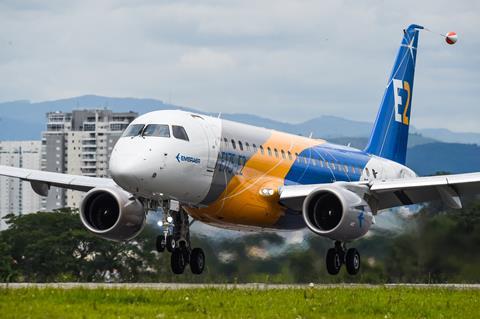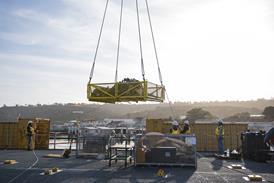The collapse of the Boeing-Embraer joint venture leaves Embraer more vulnerable as a standalone company than Boeing, raising questions about the Brazilian airframer’s ability to compete long term against Airbus, say two analysts.
Termination of the deal by Boeing also fueled speculation that Embraer will seek another major international aerospace partner, though few choices might remain, and the coronavirus pandemic has left executives questioning how the industry might change in the coming years.
“I think the situation is more acute for Embraer,” says Michel Merluzeau of aerospace consultancy AIR.

Merluzeau says both companies are now “fighting for… survival” – Boeing due to a cash crunch and the 737 Max crisis, and Embraer owing to its sudden loss of a merger partner.
“Embraer needs a partner really, really quick,” Merluzeau says.
Boeing was to purchase 80% of Embraer’s commercial aircraft division – essentially the E-Jet programme – for $4.2 billion, forming “Boeing Brasil - Commercial”.
The acquisition would add regional jets to Boeing’s aircraft line up and provide it with Embraer’s engineering expertise – assets analysts viewed as valuable in helping Boeing compete against Airbus.
Embraer would benefit from Boeing’s global supply chain and sales heft, helping reduce costs and making E-Jets more competitive against Airbus A220s.
But the deal stalled amid European regulatory holdups, and in recent months the coronavirus pandemic hammered the industry. That sparked speculation that Boeing, already struggling with the 737 Max crisis and a cash crunch, could no longer afford the deal.
On 25 April Boeing said it cancelled the agreement, walking away because Embraer “did not satisfy necessary conditions”. Embraer shot back, saying Boeing “wrongfully terminated” the agreement and “manufactured false claims”. Embraer has vowed to seek damages and commenced arbitration.
“That hurts,” Teal Group aerospace analyst Richard Aboulafia says of Embraer’s circumstances. “The only way to compete with Airbus’ supply chain muscle is to join in with Boeing’s supply chain muscle.”
Sao Jose dos Campos-based Embraer still sees a bright future, stressing the strength of its commercial, military and business aviation units.
“The competitive scenario has become more difficult, but we are ready to meet the challenges,” the airframer says in a 27 April statement. “We are leaders in the regional jet market and regional jets will lead the rebound in the aviation industry as airlines will resume their operations through regional and domestic routes.”
With the deal off the table, analysts now question whether Boeing really needed Embraer so badly in the first place.
“I don’t see how Boeing is hurt at all,” says Aboulafia, adding that Boeing has historically shown little interest in competing in the 100- to 130-seat aircraft segment, in which Embraer E-Jets reside.
“I think, deep down, the realisation probably was, there is nothing that Embraer does that Boeing can’t,” says Merluzeau. However, financial realities aside, he still thinks Boeing would be better off joining Embraer.
The analysts suspect Boeing may also be wary of buying Embraer’s commercial division while contemplating applying for billions of dollars in coronavirus relief funds available from the US government.

OTHER POTENTIAL PARTNERS
Embraer has had modest success selling E2s, which replace its wildly popular first-generation E-Jet. At the end of 2019 the company’s backlog included 153 E2s, including 16 E190-E2s and 137 E195-E2s. It held no orders for E175-E2s, which major US regional carriers largely cannot operate due to pilot-contract technicalities involving takeoff weight.
The E190 and E195 compete in roughly the same segment as the A220, formerly Bombardier’s CSeries. Bombardier sold that programme to Airbus in 2018.
Embraer is “up against a monster with a very effective cost-reduction programme,” Aboulafia says, referring to Airbus. “It’s going to be hard.”
Merluzeau thinks Embraer’s business jet programme will continue performing “reasonably” well. He says Embraer has a reputation for being “nimble and adaptable”, and thinks the company will seek a new suitor.
But who?
With only a few airframers controlling the industry, choices are limited.
Merluzeau suggests Embraer might turn to China, perhaps eying a deal with China’s AVIC. “A partner like the Chinese would give Embraer the safety net they need,” he says. “The Chinese would give Embraer massive market access.”
A strong backer might help Embraer develop the 90-seat turboprop that its executives have discussed for years. Such an aircraft could replace older designs like De Havilland Canada Dash 8-400s and ATR 72s.
A new turboprop would be more efficient on some routes than regional jets and prove popular in emerging markets, Merluzeau says. “That aircraft, I think, makes an awful lot of sense.”
But a partnership with China would prove tricky, perhaps jeopardizing Brazil’s relationship with the USA, analysts say.
Merluzeau can also envision an Embraer-Saab tie up. The companies already partner on the Gripen fighter jet programme, and Saab could use a new turboprop for a military surveillance aircraft. Such an aircraft could replace surveillance variants of Saab 340s and 2000s.
Aboulafia questions whether China would jump to spend billions for Embraer’s commercial aircraft business, noting such a partnership would highlight the struggles of China’s domestic aerospace industry and its slow-selling ARJ21 regional jet.
He thinks Embraer can survive alone, though sales could suffer.
“It is going to get very difficult to keep their place in the market,” he says.


























